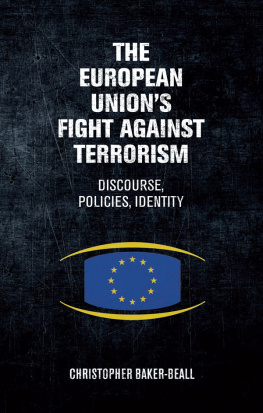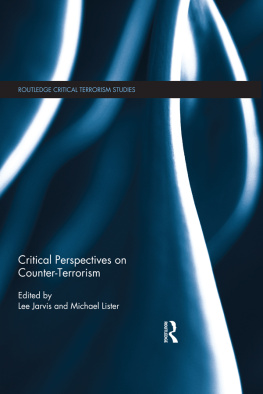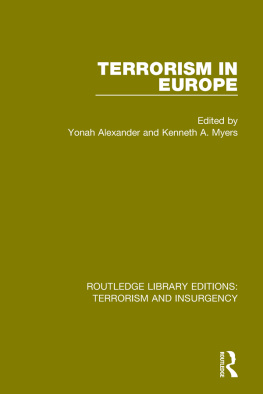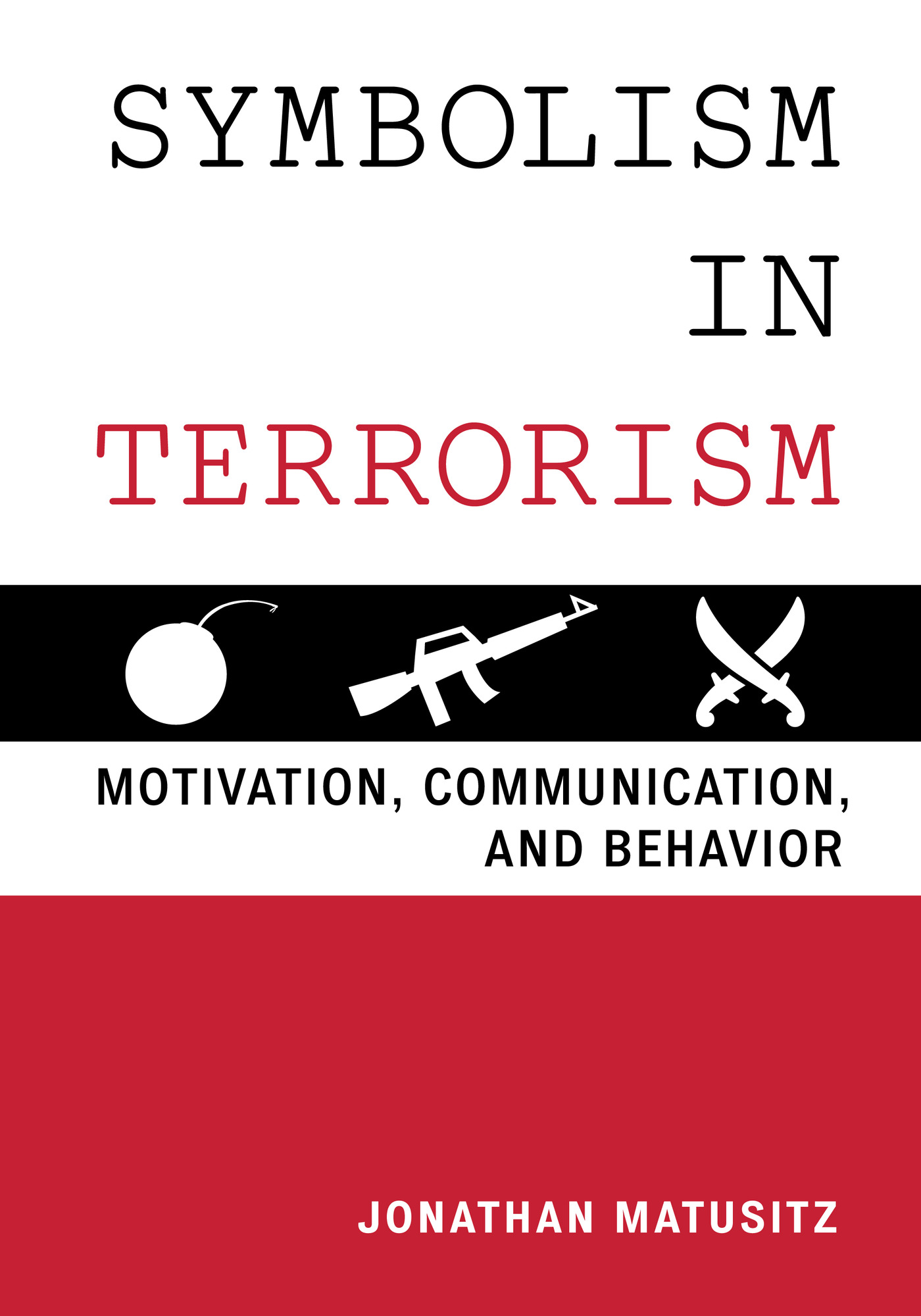Symbolism in Terrorism
Symbolism in Terrorism
Motivation, Communication, and Behavior
Jonathan Matusitz
ROWMAN & LITTLEFIELD
Lanham Boulder New York London
Published by Rowman & Littlefield
A wholly owned subsidiary of The Rowman & Littlefield Publishing Group, Inc.
4501 Forbes Boulevard, Suite 200, Lanham, Maryland 20706
www.rowman.com
16 Carlisle Street, London W1D 3BT, United Kingdom
Copyright 2015 by Rowman & Littlefield
All rights reserved. No part of this book may be reproduced in any form or by any electronic or mechanical means, including information storage and retrieval systems, without written permission from the publisher, except by a reviewer who may quote passages in a review.
British Library Cataloguing in Publication Information Available
Library of Congress Cataloging-in-Publication Data
Matusitz, Jonathan Andre, 1976
Symbolism in terrorism : motivation, communication, and behavior / Jonathan Matusitz.
pages cm. -- (Security and professional intelligence education series)
Includes bibliographical references and index.
ISBN 978-1-4422-3577-9 (cloth : alk. paper) -- ISBN 978-1-4422-3578-6 (pbk. : alk. paper) -- ISBN 978-1-4422-3579-3 (electronic)
1. Terrorism. 2. Symbolism. 3. Terrorism and mass media. I. Title.
HV6431.M3797 2014
363.325--dc23
2014019034
 TM The paper used in this publication meets the minimum requirements of American National Standard for Information Sciences Permanence of Paper for Printed Library Materials, ANSI/NISO Z39.48-1992.
TM The paper used in this publication meets the minimum requirements of American National Standard for Information Sciences Permanence of Paper for Printed Library Materials, ANSI/NISO Z39.48-1992.
Printed in the United States of America
Introduction
Overview of the Book
Symbolism in Terrorism is a single-authored book that will serve as a core text. Overall, the book presents a conceptual look at terrorism from a highly symbolic perspective. In this comprehensive analysis, which incorporates descriptions, definitions, case studies, classic and recent data, theories, excerpts from terrorists communiqus, and images, each chapter (1) isolates a specific dimension of symbolism in terrorism, (2) illustrates the contexts and processes that involve the main actors in terrorism, and (3) informs readers about the symbolism of both the purposes and targets of terrorism. In regard to the latter, it is the symbolic value of targets that differentiates terrorism from other forms of extreme violence; terrorism is designed to inflict deep psychological wounds on an enemy, rather than demolishing the enemys material ability to fight.
This book does not attempt to make a political statement. Instead, it provides an understanding of an understudied area of counterterrorism, as well as an original and thought-provoking source of inspiration for teachers, students, and experts alike. Indeed, the often overlooked role of symbolism in terrorism increasingly dominates international affairs. For example, the September 11, 2001, terrorist attacks demonstrated its power: the World Trade Center was targeted by Al Qaeda because the Twin Towers epitomized Western civilization, U.S. imperialism, financial success, modernity, and freedom. Likewise, in chapter 14, one of the many visual motifs used in Islamism is the image of the dove. Whereas in Western culture the dove carries connotations of love and peace, this is not necessarily the case in Islamism, where the dove connotes a pure Muslim who has been chosen by Allah to wage or lead holy war.
Throughout all sixteen chapters, over forty areas of symbolism are covered. Examples are physical symbolism, nonphysical symbolism, linguistic symbolism, meaning making, anthroposemiosis, the social construction of reality, symbolic interactionism, organizational culture, symbolic convergence theory, the symbolic trinity, rituals, myths, positive cults versus negative cults, Conceptual Metaphor Theory, high context versus low context, performative violence, iconoclasm, imagery, visual motifs, brand management, logos, semiotics, new media, and the Global Village. So far, no book on terrorism has examined all major aspects of symbolism in one single work. Whereas some books on that topic deal mostly with the influence of society on the self, other texts tend to focus exclusively on imagery or visual motifs used in terrorist organizations. This is acceptable but not sufficient.
Preview of All Chapters
Chapter 1 addresses the complex definition of symbolism as a specific method of communication. As such, symbolism has the objective to communicate a message by channeling information between a sender and a receiver. More precisely, a symbol is (1) a medium for conveying meaning, (2) something that stands for something else, (3) a categorization of reality, (4) a communication shortcut, and (5) communication beyond language.
In chapter 2, terrorism is defined in detail. As such, terrorism is the use of violence to create fear (i.e., terror, or psychic fear) for political, religious, or ideological reasons. This chapter is also an introduction to symbolism in terrorism. For example, the symbolic timing of a terrorist attack can be carefully selected by a terrorist group to coincide with the groups particular ideological, cultural, or religious requirements or to desecrate an enemys sacred moments (e.g., religious holidays).
Chapter 3 looks at the symbolic targets of terrorism. The success of a terrorist act is not captured by the destruction of its target, but by the realization of a symbolic act that has far-reaching repercussions for audiences worldwide. For instance, blowback theory posits that the global hegemony of empiresat both the end of the twentieth century and the beginning of the twenty-first centuryand the additional global military presence of the United States have prompted resistance in the form of terrorism and attacks on symbolic targets like the World Trade Center.
In chapter 4, the role of symbolic culture in terrorism is analyzed. A theory that can explain all this is symbolic interactionism. The theory postulates that human beings are able to communicate through shared meanings. The role of rituals is described in detail as well. A ritual is (1) a symbolic act, (2) communication, (3) a rite of purity, (4) tribalism, and (5) legitimizing cultural violence.
In chapter 5, the role of myth in symbolic terrorism is addressed. One method of looking at both myth and terrorism is symbolic convergence theory (SCT). SCT postulates that sharing group fantasies produces symbolic convergence. When humans have a good time together or have it rough together, they tend to increase group cohesion. Another three-part framework is the theory of symbolic trinity, which consists of symbolism, rhetoric, and myth.
Chapter 6 tackles the issue of symbolic place and territory in terrorism. Places and territories are often loaded with symbolism. Many ethnic groups have made claims to real or imaginary territories, a phenomenon called ethnonationalism. When terrorism is motivated by ethnonationalism, it is called separatist terrorism. In addition, terrorist groups (or their sympathizers) can express their attachment to land and ancestry through murals. Two striking cases studies in this chapter are murals in Northern Ireland and murals in the Palestinian territories.
Chapter 7 examines the symbolic relationship between terrorism and religion. When the use of religious terrorism is centered on an ideological and fanatical interpretation of selected religious scriptures, it is called junk terrorism (the hijacking of a religion). It was also found that religious terrorism regularly implies a battle between good and evil, and all-out struggle against enemies. Of equal relevance in this chapter is the fact that violent new religious movements (VNRMs) are religious-based terrorist groups that strongly believe in creating a radical transformation of society that they have been called to bring (i.e., by exterminating the world).
Next page









 TM The paper used in this publication meets the minimum requirements of American National Standard for Information Sciences Permanence of Paper for Printed Library Materials, ANSI/NISO Z39.48-1992.
TM The paper used in this publication meets the minimum requirements of American National Standard for Information Sciences Permanence of Paper for Printed Library Materials, ANSI/NISO Z39.48-1992.